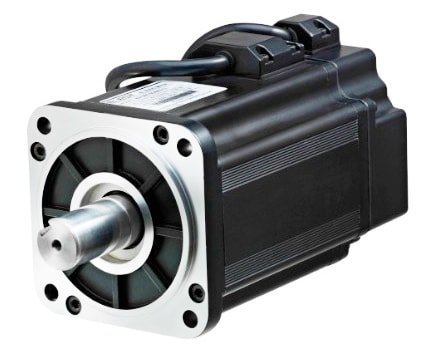A servo motor is an engine that controls the operation of a mechanical component in a servo system, and is an auxiliary motor indirect transmission.

The servo motor can control the speed and position accuracy very accurately, and can convert the voltage signal into torque and speed to drive the control object.
The servo motor rotor speed is controlled by the input signal and can react quickly.
In the automatic control system, it is used as an actuator and has characteristics such as small electromechanical time constant, high linearity, and starting voltage.
The received electrical signal can be converted to an angular displacement or angular velocity output on the motor shaft.
The servo motor is mainly divided into two major categories which is DC servo motor and AC servo motor.
Its main feature is that when the signal voltage is zero, there is no rotation phenomenon, and the rotation speed decreases uniformly with the increase of the torque.
Working principle
1) A servo mechanism is an automatic control system that enables an output controlled amount of an object to follow an arbitrary change of an input target (or a given value).
The servo is mainly positioned by pulse.
Basically, it can be understood that when the servo motor receives one pulse, it will rotate the angle corresponding to one pulse to achieve displacement.
Because the servo motor itself has the function of emitting pulses.
Therefore, each time the servo motor rotates, it will emit a corresponding number of pulses.
In this way, the pulse received by the servo motor forms an echo, or a closed loop.
In this way, the system will know how many pulses were sent to the servo motor, and how many pulses were received at the same time.
In this way, the rotation of the motor can be controlled very accurately, so that precise positioning can be achieved, which can reach 0.001 mm.
DC servo motors are divided into brushed and brushless motors.
The brush motor has low cost, simple structure, large starting torque, wide speed regulation range, easy control and maintenance.
However, it is inconvenient to maintain (change the carbon brush), generate electromagnetic interference, and have environmental requirements.
It can therefore be used in cost-sensitive general industrial and residential applications.
The brushless motor is small in size, light in weight, large in output, fast in response, high in speed, small in inertia, smooth in rotation and stable in torque.
The control is complex and easy to implement intelligent.
The electronic commutation method is flexible, and can be square wave commutation or sine wave commutation.
The motor is maintenance-free, has high efficiency, low operating temperature, low electromagnetic radiation and long life, and can be used in various environments.
2) AC servo motor is also a brushless motor, which is divided into synchronous and asynchronous motors.
At present, synchronous motors are generally used in motion control, and its power range is large, and a large power can be achieved.
High inertia, the highest rotational speed is low, and it decreases rapidly as power increases.
Therefore, it is suitable for applications with low speed and smooth operation.
3) The rotor inside the servo motor is a permanent magnet.
The U/V/W three-phase electricity controlled by the driver forms an electromagnetic field.
The rotor rotates under the action of this magnetic field, and the encoder feedback signal from the motor is supplied to the driver.
The driver compares the feedback value with the target value to adjust the angle at which the rotor rotates.
The accuracy of the servo motor is determined by the accuracy (number of lines) of the encoder.
The difference between the AC servo motor and the brushless DC servo motor: AC servo is better because it is sinusoidal control and the torque ripple is small.
The DC servo is a trapezoidal wave.
But DC servo is simpler and cheaper.
Copyright © Jiangsu Hoston Machine Tools Co., Ltd. (Hongkong Hoston Group CO., LIMITED)All Rights Reserved | Sitemap Technical Support: 